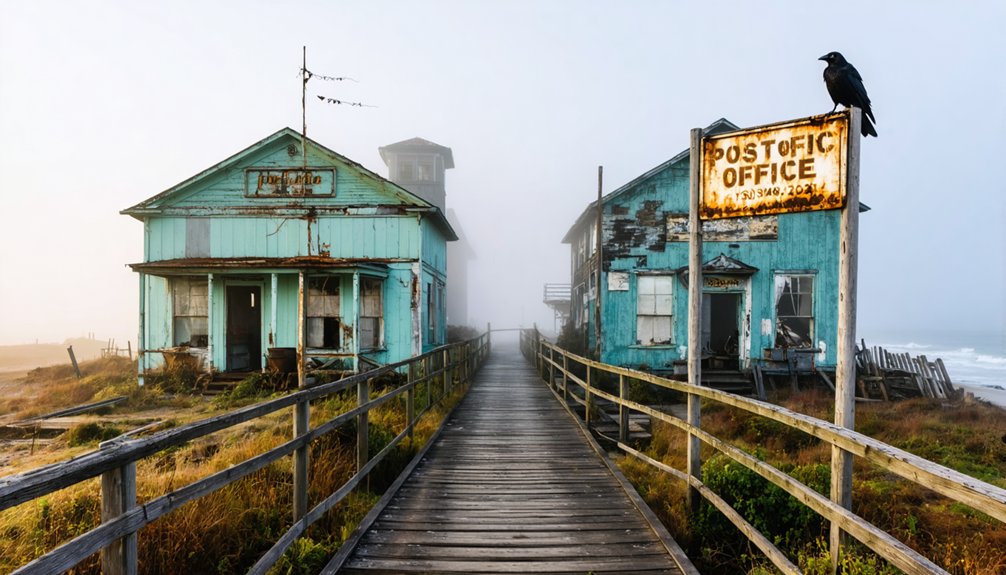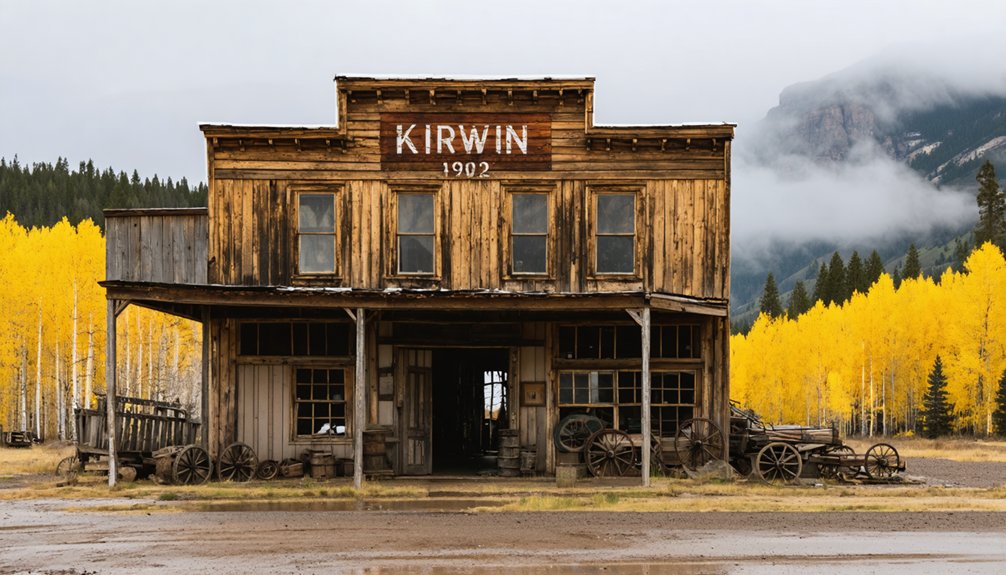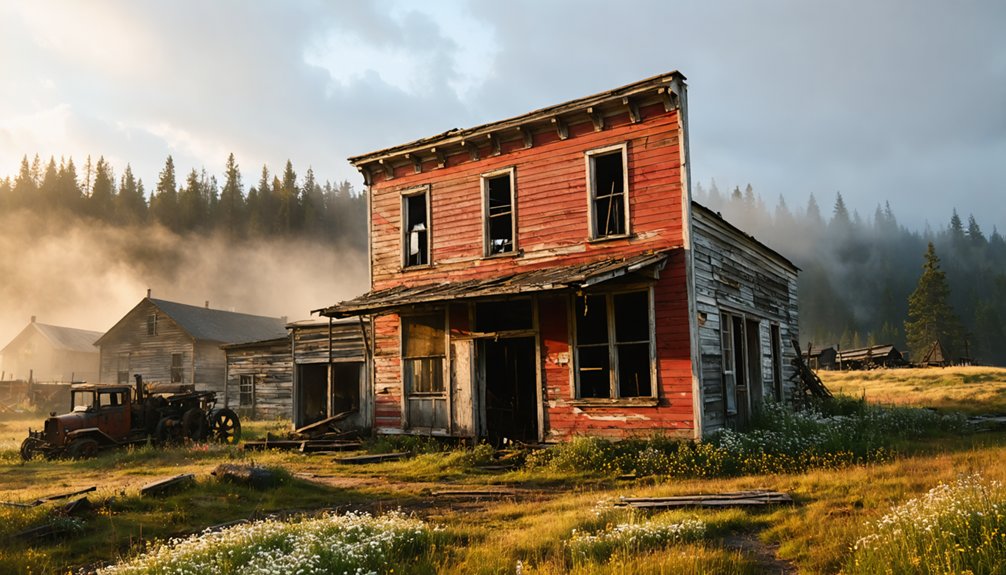When exploring Pacific Coast ghost towns, always travel with companions and share your itinerary with someone reliable. Research sites beforehand to verify legal access and historical significance. Carry essential gear including sturdy footwear, water, and first-aid supplies. Assess structural integrity before entering any buildings. Practice ethical exploration by following “leave no trace” principles and photographing rather than removing artifacts. These foundational practices guarantee a safe and meaningful journey into the West’s fascinating abandoned past.
Key Takeaways
- Always explore with at least three companions and share your itinerary with someone not in your group.
- Research the ghost town’s history and verify legal access status before visiting.
- Pack essential survival gear including sturdy footwear, water, first aid supplies, and offline maps.
- Thoroughly assess structural integrity before entering any abandoned buildings.
- Practice “leave no trace” principles and document sites without disturbing historical elements.
Safety Essentials for Remote Ghost Town Exploration
While venturing into the forgotten settlements along the Pacific Coast offers a glimpse into America’s maritime past, safety must remain your primary concern during ghost town exploration.
Always travel with at least three companions to guarantee adequate emergency preparedness—this assures assistance if injuries occur. Before departure, share your itinerary with a trusted contact, including your expected return time.
Never explore alone—a minimum of four explorers ensures someone can stay with an injured party member while others seek help.
Maintain constant group communication throughout your expedition, staying within eyesight of each other when maneuvering unstable structures. Carry proper identification for potential law enforcement encounters.
Always conduct thorough structural assessments before entering any building, looking for compromised roofs, water damage, or unstable floors. Consider carrying a satellite communication device since cell service is typically non-existent in these remote locations. Pack comfortable, sturdy shoes with good traction to safely navigate uneven terrain and overgrown pathways common in abandoned towns. Map exit routes in advance and pack essential survival gear—including first aid supplies, water, and emergency blankets—to handle unexpected situations in these isolated locations.
Planning Your Visit to Historical Abandoned Sites
Thorough preparation forms the foundation of any successful ghost town expedition along the Pacific coastline.
Begin by researching the historical significance of your destination, including economic activities that once sustained these communities. Verify legal access status and obtain any required permits to avoid trespassing violations during your urban exploration.
Select transportation appropriate for terrain conditions—many sites require high-clearance vehicles and careful fuel planning. Download offline maps and GPS coordinates, as cell service is typically unavailable. Consider the challenging elevation of destinations like Bodie State Historic Park, which sits at 8,400 feet and may require additional preparation for high-altitude conditions. Schedule your visit to maximize daylight hours and arrange nearby accommodations for multi-day explorations.
Pack essentials: sturdy footwear, layered clothing, ample water, photography equipment, and first-aid supplies.
For safety concerns, it’s advisable to explore with a travel companion rather than venturing alone into these remote locations.
Respect historical integrity by never removing artifacts, following established paths, and documenting structures without disturbing them. Your thoughtful preparation guarantees both your safety and the preservation of these fragile historical treasures.
Best Ghost Towns to Explore Along the Pacific Coast
Scattered along the rugged Pacific coastline, several remarkable ghost towns offer visitors unparalleled glimpses into the region’s boom-and-bust history.
Bodie history stands as the crown jewel—an authentic gold-mining town preserved in “arrested decay” without commercial intrusions, allowing you to experience the 1800s exactly as it was abandoned.
Calico attractions provide a more curated experience in San Bernardino County, with restored buildings and designated tourist facilities that showcase California’s mining heritage. Founded in 1881 and abandoned by 1907, Calico’s decline came after the end of borax mining operations in the area.
- Wander among North Bloomfield’s preserved structures, once home to 2,000 residents after hydraulic mining transformed “Humbug” into a thriving settlement.
- Explore Drawbridge’s remaining structures, a reflection of how infrastructure dependency led to abandonment.
- Discover Goffs in the Mojave Desert, now a research center documenting railroad history.
- Visit Rhyolite near the California-Nevada border where you can see the famous Bottle House constructed entirely from discarded beer bottles from local saloons.
Photography and Documentation Best Practices
Capturing the haunting beauty and historical significance of Pacific Coast ghost towns requires thoughtful preparation and specialized techniques. Equip yourself with a tripod, wide-angle lens, and polarizing filter to maximize your visual documentation in these remote locations.
Master lighting by shooting during golden hour when sunlight accentuates architectural details and textures. For night photography, experiment with light painting using flashlights or colored gels to selectively illuminate structures while maintaining a cool 4000K white balance. Consider exploring with a photography companion for enhanced safety and collaborative creative perspectives.
Frame your shots to tell a complete story—combine establishing wide angles with intimate close-ups of artifacts suggesting sudden abandonment. Document both exteriors and interiors, seeking unique perspectives through doorways or broken walls. Bodie State Historic Park visitors often achieve compelling results with black and white photography that emphasizes the town’s age and weathered structures.
Shoot in RAW format to preserve maximum detail for post-processing, which may include black and white conversion to enhance the timeworn aesthetic.
Preserving History: Ethical Guidelines for Ghost Town Visitors
While these weathered remnants of the past captivate our imagination, Pacific Coast ghost towns represent irreplaceable historical resources that demand conscientious stewardship from every visitor.
Ethical considerations must guide your exploration as you navigate these fragile historical ecosystems. Research access regulations before arriving and always obtain necessary permissions from property owners or managing agencies. These sites are rapidly declining due to natural forces and vandalism, making ethical visitation crucial for their survival.
Conservation strategies require your active participation through:
- Practicing “leave no trace” principles—pack out everything you bring in and leave artifacts undisturbed in their original positions
- Maintaining appropriate distance from deteriorating structures to prevent further structural compromise
- Documenting conditions without disturbing elements—photography serves preservation while handling accelerates deterioration
Remember that preservation isn’t merely a legal obligation but a collective responsibility ensuring these cultural treasures remain accessible for future generations. Sites like Bodie State Historic Park exemplify the devastating consequences of lawlessness and neglect that once characterized many mining communities during their decline.
Frequently Asked Questions
Are There Any Ghost Towns Accessible for Visitors With Mobility Limitations?
Like traversing history’s delicate corridors, you’ll find wheelchair accessibility at several ghost towns despite historic preservation challenges. Bodie offers specialized terrain wheelchairs, while Garnet and Ashcroft feature accessible main thoroughfares with varying terrain difficulties.
Can I Bring My Dog to Explore Ghost Towns?
Yes, many ghost towns allow dogs. You’ll need to follow dog-friendly policies including leashes, proper cleanup, and respecting pet-restricted areas. Prioritize pet safety by bringing water and avoiding hazardous terrain.
How Do Seasonal Changes Affect Ghost Town Accessibility?
Summer’s dry paths transform into winter’s treacherous barriers. Seasonal weather dramatically alters ghost town accessibility, with snow rendering roads impassable, while rain creates muddy conditions requiring advanced vehicles and careful planning year-round.
Are Nighttime Ghost Town Visits Permitted or Recommended?
Nighttime ghost town visits are typically prohibited without official permits. You’ll face safety concerns including reduced visibility and structural hazards, while violating local regulations can result in significant legal penalties.
What Indigenous Histories Existed Before These Towns Became “Ghost Towns”?
With 80% population decline post-1845, indigenous cultures thrived for millennia before ghost towns emerged. You’ll find their presence in historical landmarks, rock art, and sacred sites throughout the Pacific Coast region.
References
- https://en.wikipedia.org/wiki/List_of_ghost_towns_in_California
- https://whitneysmurphy.weebly.com/uploads/4/7/3/0/4730280/ghost_town_research_lesson_plan.pdf
- https://www.visitcalifornia.com/road-trips/ghost-towns/
- https://dot.ca.gov/-/media/dot-media/programs/environmental-analysis/documents/ser/townsites-a11y.pdf
- https://www.tripadvisor.com/Attractions-g28926-Activities-c47-t14-California.html
- https://m.dresshead.com/files/scholarship/Documents/Ghost_Towns_Lost_Cities_Of_The_Old_West_Shire_Usa.pdf
- https://californialocal.com/localnews/statewide/ca/article/show/51711-10-california-ghost-towns-to-see/
- https://en.wikipedia.org/wiki/Ghost_town
- https://californiahighsierra.com/trips/explore-ghost-towns-of-the-high-sierra/
- https://learningcorner.co/activity/257438



